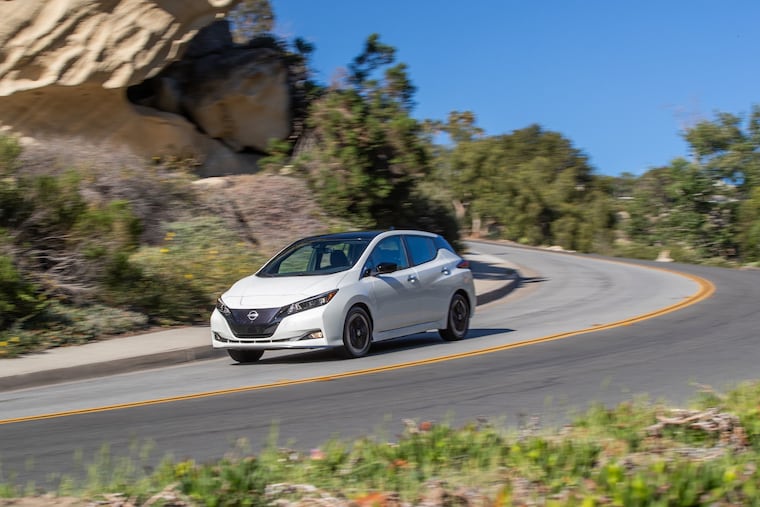2023 Nissan Leaf SV Plus: A longer leash, more powerful pull
The long-running EV Nissan Leaf hatchback has been a range-anxious driver’s nightmare. The new SV Plus edition expands the mileage.

2023 Nissan Leaf SV Plus: Welcome to the not-such-a-homebody edition.
Price: $36,040, which includes such amenities as heated seats, NissanConnect and more. (The barebones Leaf starts at $28,040.)
Conventional wisdom: Car and Driver likes the “spacious cabin for a small car, comfy seats, available semi-autonomous tech,” but not the “uncompetitive range, not compatible with all public charging stations, performance is merely OK.”
Marketer’s pitch: “Zero gas. All thrill.”
Reality: More range but still not that much.
What’s new: The Leaf gets the SV Plus edition — the model tested — which upgrades the horsepower to 214 and the range to 212 miles. The basic Leaf, around since 2011, has always had a short leash and even now just a 149-mile range.
Beyond that, a revised exterior, new wheels and some options adjustments are new for 2023.
Competition: Chevrolet Bolt EV, Tesla Model 3
Up to speed: I’ve reiterated several times over the last few weeks of reviews that EVs are all torque all the time. They have plenty of power and can pretty much run rings around gasoline-powered vehicles.
The Leaf can do that, on its own scale.
But a funny thing happened on the way to making the Leaf review. Mr. Driver’s Seat received no information about the car and assumed he had the bare-bones, run-of-the-mill Leaf. It takes that 147-horsepower Leaf 7.4 seconds to get to 60 mph, according to Car and Driver, and this felt about right for my test.
Unfortunately, the Sturgis driveway was hosting the Leaf SV Plus, which should get to 60 much more quickly. It does have some peppiness, but not a lot, and only compared with other very inexpensive cars. (I could find no reliable 0-60 data on the SV Plus.)
There’s no Sport mode here, and I appreciate not being oversold.
Back down again: The Leaf keeps its interesting ePedal feature, which allows for pretty much one-pedal driving. It’s neat to feel a car stopping pretty much on its own, but it requires some extra pressure to keep things moving.
On the road: If anyone is trying to sell buyers on the joys of owning EV’s and how they’re not the roller skates you think they may be, keep those wary consumers away from the Leaf. It’s the roller skate you think it is.
Handling is fairly indifferent. The Leaf just kind of rolls over the road with nothing memorable to draw notice, except for the little chuckle to yourself as you zip past a Wawa.
Highway driving is not bad. I took the Leaf on a 40-mile ride to Philly, and it did fine on the main highways.
Driver’s Seat: The Lovely Mrs. Passenger Seat and Car and Driver agree: The cloth seats in the Nissan Leaf are comfortable.
Mr. Driver’s Seat thought they were OK, but the driving position leaves a bit to be desired. The headrest rides way far back and feels awkward if you want to rest your head for a moment.
Otherwise, though, the seats are quite comfy and quite roomy for any car, but especially for a small one. Nissan has always made some nice upholstery.
Shiftless: Though there are no gears to speak of, one must engage Drive or Reverse somehow. The little knob that handles this function pushes up and left for Reverse and down and left for Drive. Park is a button in the middle. Smooth and functional.
Friends and stuff: The rear-seat passengers won’t be as happy, though. Headroom, foot room, and legroom are not bad, especially for the size, but the seat is much more of a compromise, and the wheel well intrudes in the corner.
The floor hump is tall and covered in cheap plastic, but a center seat is available.
Cargo space is 23.6 cubic feet behind the rear seats and 30 with the seats folded. (It matches such other small hatchbacks as the Corolla Hatchback, although Nissan’s cargo numbers always run low.)
Play some tunes: The stereo system for the Nissan Leaf is fairly common, low-end Nissan. Knobs control volume and tuning, a couple buttons hit the main points, and the eight-inch touchscreen handles everything else.
Sound from the six-speaker system is not terrible, about a B-.
Keeping warm and cool: Up-down arrows control the temperature, and buttons handle everything else.
Range: 212 miles. It can be charged up to 80% in 60 minutes. But unfortunately its high-speed charging port is not compatible with all chargers.
Where it’s built: Smyrna, Tenn.
How it’s built: Consumer Reports predicts the Leaf reliability to be a 4 out of 5, and over the last several years it has been a 4 or a 5.
In the end: Shopping for a cheap EV, do I get the roller skate with limited range, the one that flambés itself in the garage, or the one sold by the self-styled Ukraine war negotiator? Right now, I’d look behind Doors Number 2 or 3.
Next week: Let’s take a break from all this electrification. We’ll compare the GMC Terrain and Mazda CX-50 next.